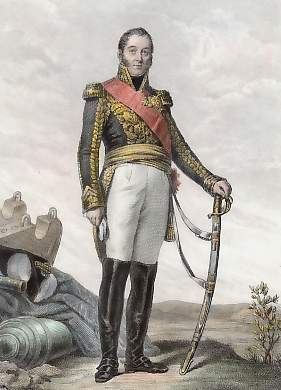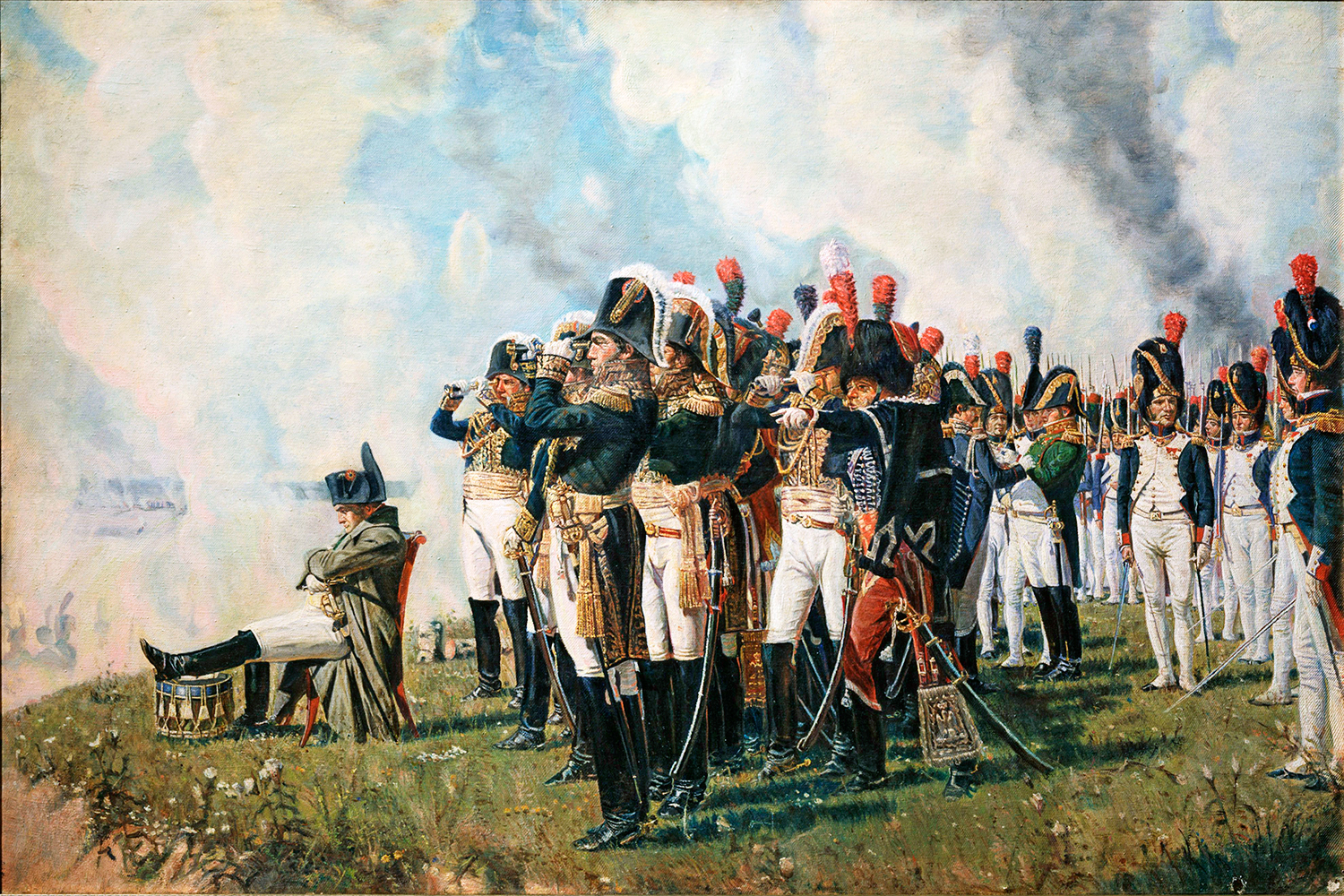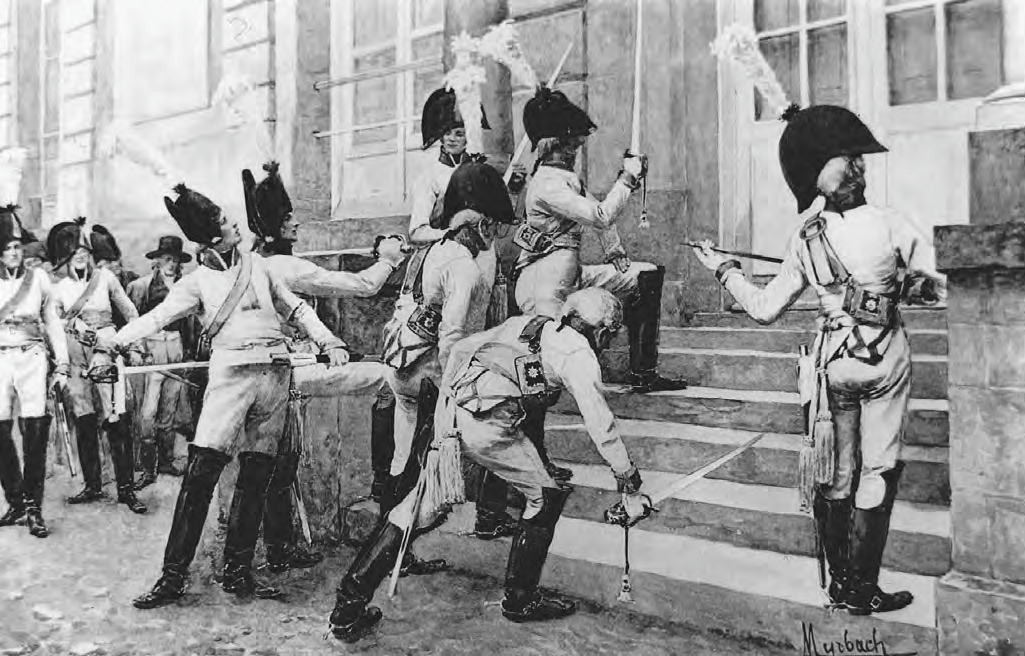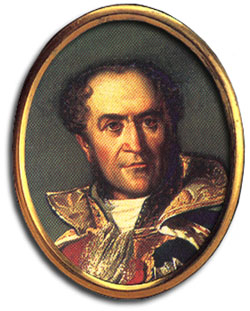|
Édouard Mortier, Duke Of Treviso
Édouard Adolphe Casimir Joseph Mortier, Duke of Treviso (; 13 February 176828 July 1835), was a French military commander and Marshal of the Empire under Napoleon, Napoleon I, who served during the French Revolutionary Wars and the Napoleonic Wars. He served as Minister of War (France), Minister of War and Prime Minister of France from 1834 to 1835. He was one of 18 people killed in 1835 during Giuseppe Marco Fieschi's assassination attempt on King Louis Philippe I. Early life Mortier was born at Le Cateau (now Le Cateau-Cambrésis), northern France, on 13 February 1768. He was the son of Charles Mortier (1730–1808), a draper, and his wife Marie Anne Joseph Bonnaire (b. 1735). After studying at the Irish College, Douai, he joined the National Guard (France), National Guard of Dunkirk in 1789, at the start of the French Revolution, and was elected captain of a unit of volunteers in September 1791. French Revolutionary Wars Upon the outbreak of the War of the First Coalition in ... [...More Info...] [...Related Items...] OR: [Wikipedia] [Google] [Baidu] |
Marshal Of The Empire
Marshal of the Empire () was a civil dignity during the First French Empire. It was established by on 18 May 1804 and to a large extent reinstated the formerly abolished title of Marshal of France. According to the ''SĂ©natus-consulte'', a Marshal was a grand officer of the Empire, entitled to a high-standing position at the court and to the presidency of an electoral college. Although in theory reserved "to the most distinguished generals", in practice Emperor of the French, Emperor Napoleon granted the title according to his own wishes and convictions and made at least a few controversial choices. Although not a military rank, a Marshal displayed four silver stars, while the top military rank, General of Division, displayed three stars. Furthermore, the Marshalate quickly became the prestigious sign of the supreme military attainment and it became customary that the most significant commands be given to a Marshal. Each Marshal held his own coat of arms, was entitled to specia ... [...More Info...] [...Related Items...] OR: [Wikipedia] [Google] [Baidu] |
War Of The First Coalition
The War of the First Coalition () was a set of wars that several European powers fought between 1792 and 1797, initially against the Constitutional Cabinet of Louis XVI, constitutional Kingdom of France and then the French First Republic, French Republic that succeeded it. They were only loosely allied and fought without much apparent coordination or agreement; each power had its eye on a different part of France it wanted to appropriate after a French defeat, which never occurred. Shusterman, Noah (2015). ''De Franse Revolutie (The French Revolution)''. Veen Media, Amsterdam. (Translation of: ''The French Revolution. Faith, Desire, and Politics''. Routledge, London/New York, 2014.) Chapter 7, pp. 271–312: The federalist revolts, the Vendée and the beginning of the Terror (summer–fall 1793). Relations between the French revolutionaries and neighbouring monarchies had deteriorated following the Declaration of Pillnitz in August 1791. Eight months later, Louis XVI and the Leg ... [...More Info...] [...Related Items...] OR: [Wikipedia] [Google] [Baidu] |
Peninsular War
The Peninsular War (1808–1814) was fought in the Iberian Peninsula by Kingdom of Portugal, Portugal, Spain and the United Kingdom of Great Britain and Ireland, United Kingdom against the invading and occupying forces of the First French Empire during the Napoleonic Wars. In Spain, it is considered to overlap with the Spanish War of Independence. The war can be said to have started when the First French Empire, French and History of Spain (1808–1874), Spanish armies Invasion of Portugal (1807), invaded and occupied Portugal in 1807 by transiting through Kingdom of Spain (1810-1873), Spain, but it escalated in 1808 after First French Empire, Napoleonic France occupied History of Spain (1808–1874), Spain, which had been its ally. Napoleon Bonaparte Abdications of Bayonne, forced the abdications of Ferdinand VII of Spain, Ferdinand VII and his father Charles IV of Spain, Charles IV and then installed his brother Joseph Bonaparte on the Spanish throne and promulgated the ... [...More Info...] [...Related Items...] OR: [Wikipedia] [Google] [Baidu] |
Battle Of Friedland
The Battle of Friedland (14 June 1807) was a major engagement of the Napoleonic Wars between the armies of the French Empire commanded by Napoleon I and the armies of the Russian Empire led by General Levin August von Bennigsen. Napoleon and the French obtained a decisive victory that routed much of the Russian army, which retreated chaotically over the Alle river by the end of the fighting. The battlefield is located in modern-day Kaliningrad Oblast, near the town of Pravdinsk, Russia. The engagement at Friedland was a strategic necessity after the Battle of Eylau earlier in 1807 had failed to yield a decisive verdict for either side. The battle began when Bennigsen noticed the seemingly isolated reserve corps of Marshal Lannes at the town of Friedland. Bennigsen, who planned only to secure his march northward to Wehlau and never intended to risk an engagement against Napoleon's numerically-superior forces, thought he had a good chance of destroying these isolated Frenc ... [...More Info...] [...Related Items...] OR: [Wikipedia] [Google] [Baidu] |
Battle Of Jena–Auerstedt
The twin battles of Jena and Auerstedt (; older spelling: ''Auerstädt'') were fought on 14 October 1806 on the plateau west of the river Saale in today's Germany, between the forces of Napoleon I of France and Frederick William III of Prussia, at the outset of the War of the Fourth Coalition during the Napoleonic Wars. The defeat suffered by the Prussian Army subjugated the Kingdom of Prussia to the French Empire until the Sixth Coalition was formed in 1813. Several figures who were later integral to the reformation of the Prussian Army participated at Jena–Auerstedt, including Gebhard von Blücher, Carl von Clausewitz, August Neidhardt von Gneisenau, Gerhard von Scharnhorst, and Hermann von Boyen. Background Following the Prussian declaration of war, Napoleon initiated his campaign against the Fourth Coalition by thrusting a 180,000-strong force through the Franconian Forest. The Prussian army, meanwhile, awaited Napoleon's advance with a force composed of about 1 ... [...More Info...] [...Related Items...] OR: [Wikipedia] [Google] [Baidu] |
War Of The Fourth Coalition
The War of the Fourth Coalition () was a war spanning 1806–1807 that saw a multinational coalition fight against Napoleon's First French Empire, French Empire, subsequently being defeated. The main coalition partners were Kingdom of Prussia, Prussia and Russian Empire, Russia with Electorate of Saxony, Saxony, Franco-Swedish War, Sweden, and United Kingdom of Great Britain and Ireland, Great Britain also contributing. Excluding Prussia, some members of the coalition had previously been fighting France as part of the War of the Third Coalition, Third Coalition, and there was no intervening period of general peace. On 9 October 1806, Prussia declared war on France and joined a renewed coalition, fearing the rise in French power after the defeat of Austrian Empire, Austria and establishment of the French-sponsored Confederation of the Rhine in addition to having learned of French plans to cede Prussian-desired Electorate of Hanover, Hanover to Britain in exchange for peace. Prussi ... [...More Info...] [...Related Items...] OR: [Wikipedia] [Google] [Baidu] |
Siege Of Kolberg (1807)
The siege of Kolberg (also spelled Colberg or Kołobrzeg) took place from March to 2 July 1807 during the War of the Fourth Coalition, part of the Napoleonic Wars. An army of the First French Empire and several foreign troops (including Polish insurgents) of France besieged the fortified town of Kolberg, the only remaining Prussian-held fortress in the Province of Pomerania. The siege was unsuccessful and was lifted upon the announcement of the Peace of Tilsit. After Prussia lost the Battle of Jena–Auerstedt in late 1806, French troops marched north into Prussian Pomerania. Fortified Stettin (Szczecin) surrendered without battle, and the province became occupied by the French forces. Kolberg resisted, and the implementation of a French siege was delayed until March 1807 by the freikorps of Ferdinand von Schill operating around the fortress and capturing the assigned French commander of the siege, Victor-Perrin. During these months, the military commander of Kolberg, Luc ... [...More Info...] [...Related Items...] OR: [Wikipedia] [Google] [Baidu] |
Siege Of Stralsund (1807)
The siege of Stralsund lasted from 24 July to 24 August, 1807, and saw troops from the First French Empire twice attempt to capture the port city from Lieutenant General Hans Henric von Essen's 15,000-man Swedish garrison. Early that year, Marshal Édouard Adolphe Casimir Joseph Mortier blockaded the city for two months before he was called elsewhere. In his absence, the Swedes drove back the inferior blockading force. After Mortier returned and pushed Essen's troops back in turn, the two sides quickly concluded an armistice. The truce was later repudiated by King Gustav IV Adolf of Sweden, and Marshal Guillaume Marie Anne Brune then led 40,000 French, German, Spanish, Italian and Dutch soldiers against the fortress. Fearfully outnumbered, the Swedes abandoned the Baltic Sea port of Stralsund to the Franco-Allies in the action during the War of the Fourth Coalition, part of the Napoleonic Wars. As a consequence, Sweden also lost the nearby island of Rügen. Prelude Sweden wa ... [...More Info...] [...Related Items...] OR: [Wikipedia] [Google] [Baidu] |
Franco-Swedish War
The Franco-Swedish War or Pomeranian War was the first involvement by Sweden in the Napoleonic Wars. The country joined the Third Coalition in an effort to defeat France under Napoleon Bonaparte. Background In 1803, the United Kingdom had declared war on France, and Sweden remained neutral, together with Denmark–Norway and Prussia. However, after the execution of Louis-Antoine-Henri de Bourbon-Condé in 1804, the Swedish government broke all diplomatic ties with France and concluded a convention to allow the British to use Swedish Pomerania as a military base against France in exchange for payments. Russia also promised Sweden that 40,000 men would come to the aid of the country if it was threatened by French forces. Therefore, on 9 August 1805 Sweden joined the Third Coalition and declared war on France on 31 October. The war Offensive against Hanover In early November 1805, a combined British, Russian and Swedish force of about 12,000 men were sent from Swedish Pomerania ... [...More Info...] [...Related Items...] OR: [Wikipedia] [Google] [Baidu] |
Battle Of Austerlitz
The Battle of Austerlitz (2 December 1805/11 Frimaire An XIV French Republican calendar, FRC), also known as the Battle of the Three Emperors, was one of the most important military engagements of the Napoleonic Wars. The battle occurred near the town of Slavkov u Brna, Austerlitz in the Austrian Empire (now Slavkov u Brna in the Czech Republic). Around 158,000 troops were involved, of which around 24,000 were killed or wounded. The battle is often cited by military historians as one of Napoleon's tactical masterpieces, in the same league as other historic engagements like Hannibal's Battle of Cannae, Cannae (216 BC) or Alexander the Great's Battle of Gaugamela, Gaugamela (331 BC).Byron Farwell, Farwell p. 64. "Austerlitz is generally regarded as one of Napoleon's tactical masterpieces and has been ranked as the equal of Arbela, Cannae, and Leuthen."Trevor N. Dupuy, Dupuy p. 102 Note: Dupuy was not afraid of expressing an opinion, and he classified some of his subjects as Great ... [...More Info...] [...Related Items...] OR: [Wikipedia] [Google] [Baidu] |
Battle Of DĂĽrenstein
The Battle of Dürenstein (; also known as Dürrenstein, Dürnstein and Diernstein) or the Battle of Krems (), on 11 November 1805, was an engagement in the Napoleonic Wars during the War of the Third Coalition. Dürenstein (modern Dürnstein), Austria, is located in the Wachau valley, on the river Danube, upstream from Vienna, Austria. The river makes a crescent-shaped curve between Dürnstein and nearby Krems an der Donau, and the battle was fought in the flood plain between the river and the mountains. At Dürenstein, a combined force of Russian and Austrian troops trapped a French division commanded by Théodore Maxime Gazan. The French division was part of the newly created VIII Corps, the so-called ''Corps Mortier'', under command of Édouard Mortier. In pursuing the Austrian retreat from Bavaria, Mortier had over-extended his three divisions along the north bank of the Danube. Mikhail Kutuzov, commander of the Coalition force, enticed Mortier to send Gazan's division ... [...More Info...] [...Related Items...] OR: [Wikipedia] [Google] [Baidu] |
Battle Of Ulm
The Battle of Ulm on 16–19 October 1805 was a series of skirmishes, at the end of the Ulm Campaign, which allowed Napoleon I to trap an entire Austrian army under the command of Karl Freiherr Mack von Leiberich with minimal losses and to force its surrender near Ulm in the Electorate of Bavaria. Background In 1805, the United Kingdom, the Austrian Empire, Sweden, and the Russian Empire formed the Third Coalition to overthrow the French Empire. When Bavaria sided with Napoleon, the Austrians, 72,000 strong under Mack, prematurely invaded while the Russians were still marching through Poland. The Austrians expected the main battles of the war to take place in northern Italy, not Germany, and intended only to protect the Alps from French forces. A popular but apocryphal legend has it that while the Austrians used the Gregorian calendar, the Russians were still using the Julian calendar. This meant that their dates did not correspond, and the Austrians were brought i ... [...More Info...] [...Related Items...] OR: [Wikipedia] [Google] [Baidu] |











